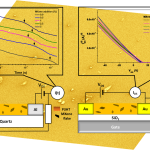In our latest work, we investigated charge transport in organic semiconductors blended with two-dimensional (2D) Ti₃C₂Tₓ MXene flakes. Ti3C2Tx, the first synthesized and most studied member of the MXene family, is known for its exceptional metallic conductivity, high capacitance, and solution processability. These properties make it a strong candidate for next-generation optoelectronic and energy storage applications. We fabricated a series of thin films by blending Poly(3-hexylthiophene-2,5-diyl) (P3HT), a widely used organic semiconductor, with Ti₃C₂Tₓ flakes at various concentrations. Charge carrier transport was characterized using the time-of-flight photoconductivity (TOFP) method, revealing a remarkable 370% increase in mobility compared to pristine P3HT. To complement these findings, we also fabricated organic field-effect transistors (OFETs) using the same P3HT:MXene blends. The OFETs exhibited a 20% enhancement in field-effect mobility, a more modest gain due to the influence of contact resistance and interface effects inherent to the device geometry—effects that are absent in TOFP measurements. These results demonstrate the potential of MXene-based hybrid systems for improving charge transport in organic electronics. The significant mobility enhancement, particularly in TOFP measurements, underscores the promise of P3HT:MXene composites for high-performance, solution-processable semiconducting materials. The results are published in Material Letters X.
Archives
- May 2025
- July 2024
- March 2024
- August 2023
- June 2023
- November 2021
- April 2021
- March 2021
- January 2021
- December 2020
- September 2020
- May 2020
- December 2018
- November 2017
- September 2017
- August 2017
- March 2017
- January 2017
- October 2016
- June 2016
- October 2015
- March 2015
- October 2014
- April 2014
- January 2014
- June 2013
- May 2013
- January 2013
- September 2012
- July 2012
- June 2012

